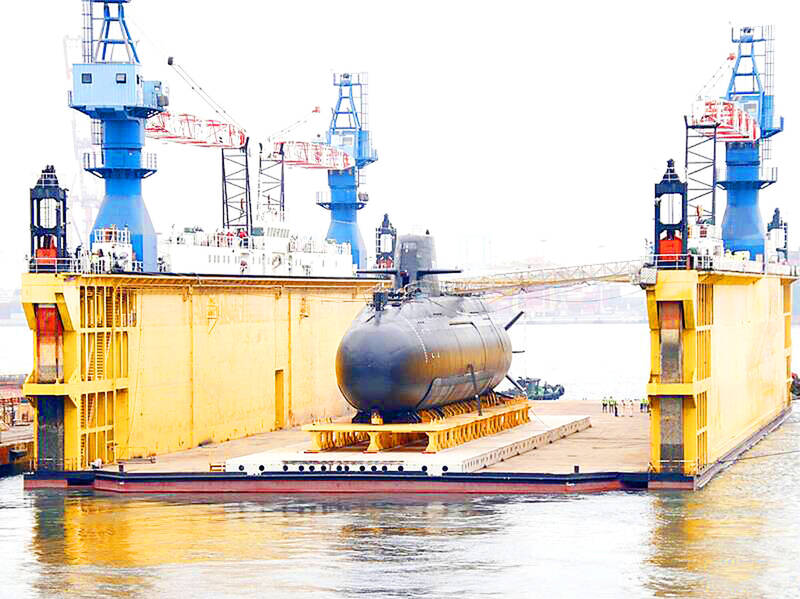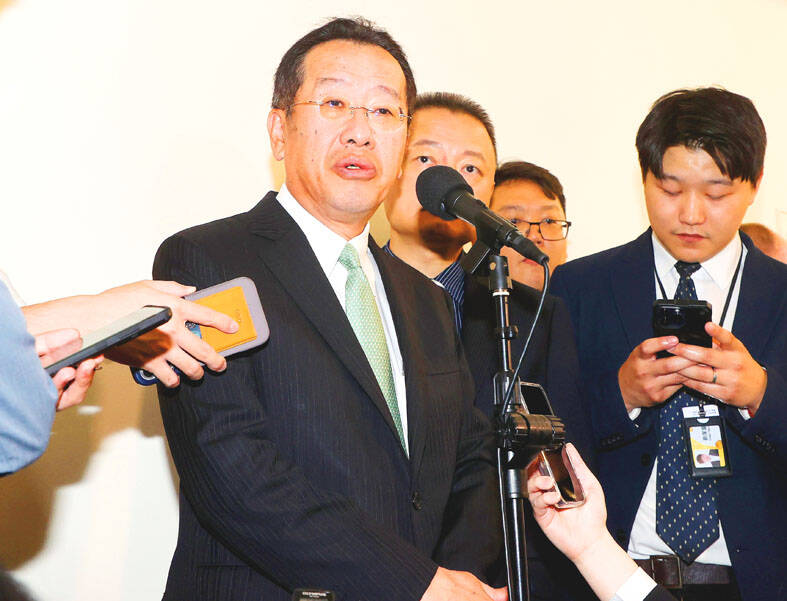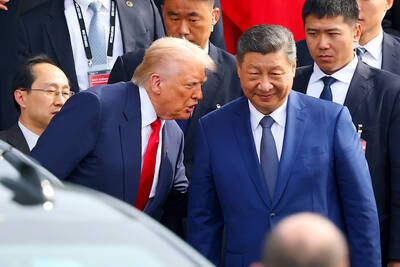The harbor acceptance test (HAT) for the Hai Kun (海鯤), or “Narwhal,” an indigenous defense submarine (IDS) prototype, is nearly complete and the vessel is expected to be delivered to the navy before the end of next year as scheduled, the navy said yesterday.
The HAT for the IDS prototype is 83 to 85 percent complete, Republic of China Navy Chief of Staff Vice Admiral Chiu Chun-jung (邱俊榮) told a meeting of the legislature’s Foreign Affairs and National Defense Committee.
This would be followed by a sea acceptance test (SAT), which is expected to begin in April next year and conclude by October before the vessel is delivered in November, Chiu said, adding that the testing process is on time and on schedule.

Photo: Lee Hui-chou, Taipei Times
Taiwan’s first domestically built submarine prototype was unveiled in Kaohsiung in September last year at a ceremony presided over by then-president Tsai Ing-wen (蔡英文). The prototype began HAT in October last year and has been going through the final stages of the process since Feb. 27.
The IDS project is part of a proposal by the military to build seven submarines from next year to 2038 at an estimated cost of NT$284 billion (US$8.74 billion), which was approved by the Cabinet on Aug. 30. The budget proposal still needs to clear the Legislative Yuan.
For next fiscal year, the Ministry of National Defense has budgeted approximately NT$1.996 billion for the production of new submarines.

Photo: CNA
Minister of National Defense Wellington Koo (顧立雄) said that the government would not spend a dime on construction plans for new submarines until the Hai Kun prototype passes its sea acceptance test, but that not allocating a budget this year might affect the progress of the construction plan.
Koo made the remarks in response to media queries for comment after Chinese Nationalist Party (KMT) Legislator Hsu Chiao-hsin (徐巧芯) said that she would propose slashing the budget by NT$1.796 billion, while fellow KMT legislators Huang Ren (黃仁) and Ma Wen-jun (馬文君) said they would propose eliminating the entire budget.
If the fund is budgeted this year, the navy can quickly use it to build new submarines if the Hai Kun passes its sea acceptance test next year, Koo said.
“If the budget is not compiled this year, but compiled after the SAT is passed, it might make it to the budget preparation deadline in August next year. The budget for submarines would thus not be compiled until the year after next. The entire schedule for subsequent submarines would be delayed as a result,” Koo said.
Koo pledged that the budget plan would be compiled based on the testing results of the prototype submarine, and the ministry would submit the plan to the Legislative Yuan for review.
KMT Legislator Chen Yeong-kang (陳永康) said he believed that it is not the budget that affects the submarine-building schedule, but CSBC Corp, Taiwan’s (台船公司) unclear shipbuilding schedule.
Workers, schedules and facilities that are involved in shipbuilding are not isolated issues, and the government cannot budget funds ahead of time without knowing whether the schedule and quality of the submarines match expectations, he said.
The ministry has not disclosed details of submarine contracts and export license conditions either, he said.
The first and second phases of domestic submarine production began in 2016 and lasted for eight years, but the funding for the third phase needs to be budgeted all the way until 2038, Hsu said.
She suggested re-evaluating the whole process by separating the budget items into “2 + 3 + 2” as stages for the indigenous submarine building program, adding that this would enable a more efficient use of the defense ministry’s budget.
Democratic Progressive Party Legislator Wang Ting-yu (王定宇), coconvener of the Foreign Affairs and National Defense Committee, said that the ministry’s budget plan of close to NT$2 billion is not high in proportion to the total fiscal budget.
“The budget plan to facilitate progress on this path to safeguarding the security of our nation,” he said.
Taiwan People’s Party (TPP) Legislator Lin Yi-chun (林憶君) said she would opt to “freeze” instead of cutting the budget.
As the prototype is still undergoing testing, she said she would propose freezing the budget by half.
TPP caucus whip Huang Kuo-chang (黃國昌) said that the party has always believed that Taiwan should bolster its national defense, adding that it would support a military procurement budget that is necessary and meets national needs.
“However, the testing of the first prototype submarine has not been completed. Without testing results, nobody knows if the first ship would be a success. The responsible approach is to compile the budget according to the construction schedule,” Huang said.
Additional reporting by Chen Yu-fu

CALL FOR SUPPORT: President William Lai called on lawmakers across party lines to ensure the livelihood of Taiwanese and that national security is protected President William Lai (賴清德) yesterday called for bipartisan support for Taiwan’s investment in self-defense capabilities at the christening and launch of two coast guard vessels at CSBC Corp, Taiwan’s (台灣國際造船) shipyard in Kaohsiung. The Taipei (台北) is the fourth and final ship of the Chiayi-class offshore patrol vessels, and the Siraya (西拉雅) is the Coast Guard Administration’s (CGA) first-ever ocean patrol vessel, the government said. The Taipei is the fourth and final ship of the Chiayi-class offshore patrol vessels with a displacement of about 4,000 tonnes, Lai said. This ship class was ordered as a result of former president Tsai Ing-wen’s (蔡英文) 2018

UKRAINE, NVIDIA: The US leader said the subject of Russia’s war had come up ‘very strongly,’ while Jenson Huang was hoping that the conversation was good Chinese President Xi Jinping (習近平) and US President Donald Trump had differing takes following their meeting in Busan, South Korea, yesterday. Xi said that the two sides should complete follow-up work as soon as possible to deliver tangible results that would provide “peace of mind” to China, the US and the rest of the world, while Trump hailed the “great success” of the talks. The two discussed trade, including a deal to reduce tariffs slapped on China for its role in the fentanyl trade, as well as cooperation in ending the war in Ukraine, among other issues, but they did not mention

Japanese Prime Minister Sanae Takaichi yesterday lavished US President Donald Trump with praise and vows of a “golden age” of ties on his visit to Tokyo, before inking a deal with Washington aimed at securing critical minerals. Takaichi — Japan’s first female prime minister — pulled out all the stops for Trump in her opening test on the international stage and even announced that she would nominate him for a Nobel Peace Prize, the White House said. Trump has become increasingly focused on the Nobel since his return to power in January and claims to have ended several conflicts around the world,

GLOBAL PROJECT: Underseas cables ‘are the nervous system of democratic connectivity,’ which is under stress, Member of the European Parliament Rihards Kols said The government yesterday launched an initiative to promote global cooperation on improved security of undersea cables, following reported disruptions of such cables near Taiwan and around the world. The Management Initiative on International Undersea Cables aims to “bring together stakeholders, align standards, promote best practices and turn shared concerns into beneficial cooperation,” Minister of Foreign Affairs Lin Chia-lung (林佳龍) said at a seminar in Taipei. The project would be known as “RISK,” an acronym for risk mitigation, information sharing, systemic reform and knowledge building, he said at the seminar, titled “Taiwan-Europe Subsea Cable Security Cooperation Forum.” Taiwan sits at a vital junction on